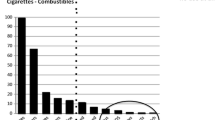Abstract
For decades, the tobacco industry has promoted myths of relative product safety to reduce consumer anxieties and sustain markets. Waves of litigation that deemed the tobacco industry financially and morally culpable for smoking disease also exposed internal company documents demonstrating that claims about product safety (e.g., “light” cigarettes) were strategically misleading. In the US, the tobacco industry now engages with public health via a different set of strategies than in the past, including corporate social responsibility claims and a renewed emphasis on potentially safer cigarettes. In this article, I examine some economic and ethical paradoxes of these contentious strategies, focusing on Philip Morris’s unlikely support of legislation granting the Food and Drug Administration (FDA) regulative authority over tobacco products. The company’s engagement with public health is a means of limiting corporate liability, deflecting risk assumption for smoking disease onto consumers, and broadening harm reduction approaches to enable the tobacco industry's competition with the pharmaceutical industry’s medicinal nicotine products.
Similar content being viewed by others
References
Brandt, Allan M. 2007. The cigarette century: The rise, fall, and deadly persistence of the product that defined America. New York: Basic Books.
Fairchild, Amy, and James Colgrove. 2004. Out of the ashes: The life, death, and rebirth of the “safer” cigarette in the United States. American Journal of Public Health 94 (2): 192–204.
Givel, Michael. 2007. FDA legislation. Tobacco Control 16: 217–218.
Hatsukami, D.K., et al. 2004. Harm reduction approaches to reducing tobacco-related morality. Annual Review of Public Health 25: 377–395.
Hsu, Spenser S. 2001. Davis’s bill on tobacco is criticized; Philip Morris stands to benefit, foes say. Washington Post, June 22: B1.
Institute of Medicine. 2001. Clearing the smoking: Assessing the science base for tobacco harm reduction. Washington DC: National Academy Press.
Jain, Sarah S. Lochlann. 2004. Come up to the Kool taste. Public Culture 15 (2): 295–322.
Kessler, David A. 2001. A question of intent: A great American battle with a deadly industry. New York: Public Affairs.
Layton, Lyndsey. 2009. Bill gives FDA broad powers to regulate tobacco. Washington Post, June 11.
McDaniel, P.A., and R.E. Malone. 2005. Understanding Philip Morris’s pursuit of U.S. government regulation of tobacco. Tobacco Control 14: 193–200.
Montopoli, Brian. 2009. Tobacco bill’s big winner: Philip Morris? CBS News. Electronic document, http://www.cbsnews.com/blogs/2009/06/11/business/econwatch/entry5081439.shtml.
Myers, Matthew L. 2004. Opposition in search of a rationale: The case for food and drug administration regulation. Tobacco Control 13: 441–443.
National Institute for Tobacco-Free Kids. 2003. Major issues and questions raised regarding FDA legislation. Electronic document, http://www.tobaccofreekids.org/research/factsheets/pdf/0189.pdf. Accessed January 2008.
New York Times. 2009. Tobacco regulation, at last. New York Times, June 11. Electronic document, http://www.nytimes.com/2009/06/12/opinion/12fri1.html.
Philip Morris, USA. 2008. FDA regulation of tobacco products. Electronic document, http://www.philipmorrisusa.com/en/legislationregulation/fda/regulationtobaccoproducts.asp. Accessed February.
Pierce, John P. 2002. Harm reduction or harm maintenance? Nicotine & Tobacco Research 4 (Supplement 2): 53–54.
Saul, Stephanie. 2008. Bill to regulate tobacco. New York Times, April 3: C3.
Shatenstein, Stan. 2004. Food and Drug Administration regulation of tobacco products: Introduction. Tobacco Control 13: 438.
Shiffman, S., et al. 2002. Tobacco harm reduction: Conceptual structure and nomenclature for analysis and research. Nicotine & Tobacco Research 4 (2): 113–129.
Siegel, Michael. 2004. Food and Drug Administration regulation of tobacco: Snatching defeat from the jaws of victory. Tobacco Control 13: 439–441.
World Health Organization. 2008. WHO report on the global tobacco epidemic, 2008—the MPOWER package. Electronic document, http://www.who.int/tobacco/mpower/en/index.html. Accessed January.
Author information
Authors and Affiliations
Corresponding author
Rights and permissions
About this article
Cite this article
Benson, P. Safe cigarettes. Dialect Anthropol 34, 49–56 (2010). https://doi.org/10.1007/s10624-009-9121-x
Received:
Accepted:
Published:
Issue Date:
DOI: https://doi.org/10.1007/s10624-009-9121-x




